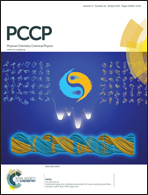Synthesis, characterization and theoretical studies of nonlinear optical crystal Sr2B5O9(OH)·H2O†
Abstract
Strontium borate Sr2B5O9(OH)·H2O (space group C2, No. 5) has been synthesized in high yields using a facile hydrothermal method. The UV-Vis-NIR diffuse reflectance spectrum shows that it has a wide transparency range extending from UV to NIR with the short-wavelength cut off edge below 190 nm. Second-harmonic generation (SHG) has been measured with a 1064 nm laser using the Kurtz and Perry technique, which shows that Sr2B5O9(OH)·H2O is phase matchable and the powder SHG effect is approximately 3 times that of KDP. It also has a high thermal stability up to 500 °C which has been identified by TG, DSC and variable-temperature PXRD. These properties make it possible for application as a UV nonlinear optical (NLO) material. Based on the electronic band structure, the optical refractive indices, birefringence, and SHG coefficients of Sr2B5O9(OH)·H2O are calculated, which are consistent with experiments. In addition, the electronic structure, SHG-weighted electron density and real-space atom-cutting analyses are performed to elucidate the origin of its NLO properties.


 Please wait while we load your content...
Please wait while we load your content...